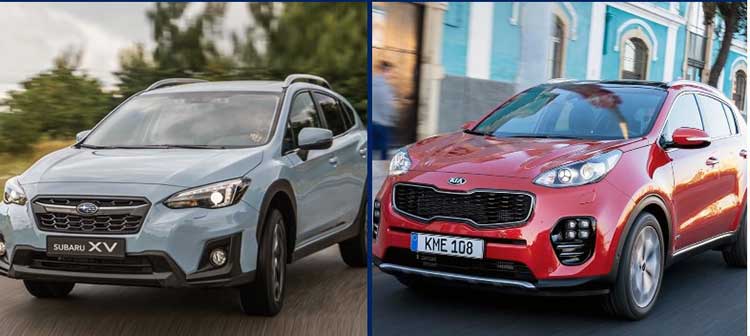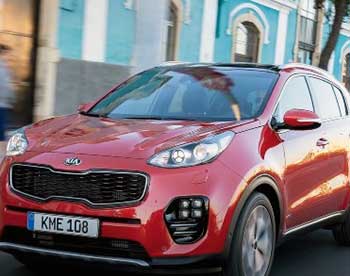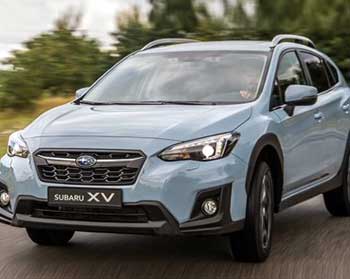When I set out to find the perfect compact SUV, the Kia Sportage and Subaru Crosstrek quickly rose to the top of my list. Both vehicles promise practicality, style, and adventure-ready features, but which one truly fits my lifestyle—or yours? In this article, I’m sharing my firsthand analysis of these two popular crossovers, breaking down their pros, cons, and key features to help you decide which one deserves a spot in your driveway.
From performance to comfort, I’ll explore what makes each SUV shine and where they fall short.

Comparison Table of Kia Sportage vs Subaru Crosstrek
| Feature | Kia Sportage (2025) | Subaru Crosstrek (2025) |
| Starting MSRP | $28,785 | $27,230 |
| Engine Options | 2.5L 4-cylinder (187 hp), Hybrid, Plug-in Hybrid (261 hp) | 2.0L 4-cylinder (152 hp), 2.5L 4-cylinder (182 hp), Hybrid |
| Fuel Economy (City/Hwy) | 25/32 MPG (gas), 43/44 MPG (hybrid) | 28/33 MPG (gas), 45 MPG combined (hybrid) |
| Cargo Capacity | 39.6 cu. ft. (seats up), 74.1 cu. ft. (seats down) | 19.9 cu. ft. (seats up), 54.7 cu. ft. (seats down) |
| Ground Clearance | Up to 8.3 inches | 8.7 inches (9.3 inches on Wilderness trim) |
| Drivetrain | FWD standard, AWD available | AWD standard |
| Warranty | 10 years/100,000 miles (powertrain) | 5 years/60,000 miles (powertrain) |
| Safety Rating | IIHS Top Safety Pick (2024) | IIHS Top Safety Pick (2024) |
| Infotainment | 8-inch or 12.3-inch touchscreen, Apple CarPlay/Android Auto | 6.5-inch or 11.6-inch touchscreen, Apple CarPlay/Android Auto |
| Interior Space | 41.4 in. front legroom, 41.3 in. rear legroom | 42.9 in. front legroom, 36.5 in. rear legroom |
My Journey with Compact SUVs
I’ve always been drawn to compact SUVs for their versatility. They’re big enough to handle family road trips or gear-heavy adventures but small enough to navigate city streets without feeling like you’re piloting a tank. Over the years, I’ve driven my fair share of crossovers, from zippy urban runabouts to rugged off-roaders.
The Kia Sportage and Subaru Crosstrek caught my attention because they cater to drivers like me—people who want a blend of practicality, tech, and a touch of adventure. I’ve test-driven both, pored over specs, and even chatted with owners to get a real-world feel. My goal? To figure out which of these SUVs better balances daily commutes with weekend escapes.
Exterior Design and First Impressions

The Kia Sportage’s bold, futuristic look grabbed me first.
Its tiger-nose grille and sleek LED headlights give it a confident, almost premium vibe. Driving through my neighborhood, I noticed heads turning—it’s a head-turner, no doubt.
The Sportage feels modern, with clean lines and a slightly longer body (183.5 inches) that gives it a substantial presence.
Higher trims like the X-Pro add rugged touches like all-terrain tires, perfect for light off-roading.
The Subaru Crosstrek, on the other hand, has a rugged, utilitarian charm. Its 2024 refresh sharpened its look with a stiffer chassis and updated front fascia, but it still feels like a Subaru—practical and unpretentious. At 176.5 inches long, it’s more compact, which I appreciated when squeezing into tight parking spots. The Wilderness trim, with 9.3 inches of ground clearance and chunkier tires, screams “take me camping.” Both SUVs look adventure-ready, but the Sportage leans toward style, while the Crosstrek embraces function.
Performance and Driving Experience
Under the hood, the Kia Sportage offers a 2.5-liter 4-cylinder engine pumping out 187 horsepower, which felt peppy enough for highway merges and city traffic. I was impressed by its smooth 8-speed automatic transmission, which shifted seamlessly during my test drive. For those craving more power, the plug-in hybrid (PHEV) variant delivers 261 horsepower and a 32-mile electric range—ideal for short commutes. The Sportage’s ride is supple, soaking up bumps with ease, though I noticed some body roll in tight corners. Off-road, the X-Pro trim handled gravel trails well, but it’s not a hardcore trailblazer

The Subaru Crosstrek’s base 2.0-liter engine (152 horsepower) felt underpowered, especially when passing on the highway.
The 2.5-liter option (182 horsepower) in higher trims like the Sport and Limited was a better match, though still not as punchy as the Sportage.
Subaru’s continuously variable transmission (CVT) was smooth but occasionally droned during acceleration.
What stood out was the Crosstrek’s standard all-wheel drive (AWD),
which gave me confidence on wet roads and light trails. Its 8.7-inch ground clearance (9.3 in the Wilderness) made it feel more planted off-pavement than the Sportage.
Fuel Efficiency and Running Costs
Fuel economy matters to me, especially with gas prices fluctuating. The Subaru Crosstrek edges out the Sportage here, with its base gas engine achieving 28 MPG city and 33 MPG highway compared to the Sportage’s 25/32 MPG. The Crosstrek’s hybrid gets an impressive 45 MPG combined, while the Sportage’s hybrid manages 43/44 MPG (city/highway). For long-term savings, the Sportage’s PHEV option is tempting if you can charge regularly, but its higher upfront cost might not suit everyone.
Maintenance costs also tilt in Kia’s favor. The Sportage’s 10-year/100,000-mile powertrain warranty is double the length of Subaru’s 5-year/60,000-mile coverage, giving me peace of mind for long-term ownership. Plus, with 23% more Kia dealers nationwide, servicing is more convenient. However, Subaru’s reputation for durability means the Crosstrek might need fewer repairs over time, though I found mixed owner feedback on this.
Interior Comfort and Space
Stepping inside the Sportage, I was struck by its upscale cabin. The 12.3-inch touchscreen (standard on higher trims) felt like something from a luxury SUV, and the layout was intuitive. Cloth seats in the base model were comfy, but I preferred the synthetic leather in the SX trim. With 41.3 inches of rear legroom, my 6-foot-tall friend had no complaints sitting in the back. The Sportage’s cargo space is a standout—39.6 cubic feet with seats up and 74.1 cubic feet with seats folded. I easily fit a weekend’s worth of camping gear without sacrificing passenger space.
The Crosstrek’s interior is more functional than flashy. Its 11.6-inch touchscreen (available on higher trims) was responsive, but the base 6.5-inch screen felt dated. Front legroom (42.9 inches) was generous, but the rear’s 36.5 inches felt cramped for taller passengers. Cargo space is a weak point—19.9 cubic feet with seats up and 54.7 cubic feet with seats down. I struggled to fit larger items like a cooler without folding the seats. However, the Crosstrek’s elevated driving position and excellent visibility made urban driving a breeze.
Technology and Infotainment
Both SUVs pack modern tech, but the Sportage feels a step ahead. Its 8-inch or 12.3-inch touchscreen supports wireless Apple CarPlay and Android Auto, and the interface is snappy. Higher trims offer a Harman Kardon audio system that made my playlists sound crisp. Features like remote smart parking (using the key to maneuver in tight spaces) impressed me, though I rarely used it. The Sportage’s menu system is straightforward, and I appreciated the physical knobs for climate controls.
The Crosstrek’s Starlink infotainment system is solid, with standard Apple CarPlay and Android Auto. The 11.6-inch touchscreen on higher trims is user-friendly, but the base 6.5-inch screen lags behind. Subaru’s optional Harman Kardon system was decent but not as immersive as the Sportage’s. I liked the Crosstrek’s physical buttons for quick access to settings, especially while driving. Both SUVs offer wireless charging and multiple USB ports, but the Sportage’s tech feels more polished overall.
Also Read: Kia Stinger vs. Genesis G70
Safety Features and Ratings
Safety is non-negotiable for me, and both SUVs deliver. The Sportage and Crosstrek earned 2024 IIHS Top Safety Pick awards, with standard features like automatic emergency braking, lane-keep assist, and adaptive cruise control. The Sportage’s safety tech is standard across all trims, which I appreciated. Its crash test results, especially in the IIHS’s tougher side-impact test, outperformed the Crosstrek slightly, giving me extra confidence.
Subaru’s EyeSight suite is excellent, with responsive adaptive cruise control and lane-centering that worked well on highways. However, some features, like advanced crash avoidance, require opting for the CVT over the manual transmission. Both SUVs have blind-spot monitoring and rearview cameras, but the Sportage’s 360-degree camera on higher trims made parking a cinch.
Off-Road Capability
I’m no hardcore off-roader, but I love weekend trails and occasional snow trips. The Crosstrek shines here, thanks to its standard AWD and higher ground clearance. During a test drive on a muddy forest trail, the Wilderness trim handled ruts and gravel like a champ. Subaru’s X-Mode optimizes traction for snow, mud, or sand, making it a go-to for outdoor enthusiasts.
The Sportage, with available AWD and up to 8.3 inches of ground clearance, is capable but less rugged. It managed light trails fine, but I wouldn’t push it on tough terrain. The X-Pro trim adds all-terrain tires and a terrain mode, but it can’t match the Crosstrek’s off-road prowess. If you’re mostly sticking to pavement, the Sportage’s smoother ride might be enough.
Pros and Cons of the Kia Sportage
- Powerful Engine Options: The 2.5-liter engine (187 hp) and PHEV (261 hp) offer strong performance.
- Spacious Interior: Ample rear legroom and class-leading cargo space.
- Long Warranty: 10 years/100,000 miles for powertrain coverage.
- Premium Tech: Large touchscreen, intuitive infotainment, and advanced safety features.
- Stylish Design: Eye-catching exterior stands out in the compact SUV class.
Cons
- Lower Fuel Economy: Gas models lag behind the Crosstrek in MPG.
- Higher Starting Price: Starts at $28,785, about $1,500 more than the Crosstrek.
- Limited Off-Road Ability: Not as capable as the Crosstrek on rough terrain.
- Body Roll: Noticeable in sharp turns, less agile than some rivals.
Pros and Cons of the Subaru Crosstrek
- Standard AWD: Excellent traction for all weather and light off-roading.
- Fuel Efficiency: Better MPG than the Sportage, especially in hybrid form.
- Off-Road Capability: Higher ground clearance and X-Mode make it adventure-ready.
- Resale Value: Retains 15.2% more value over five years than the Sportage.
- Compact Size: Easier to park and maneuver in tight spaces.
Cons
- Underpowered Base Engine: 2.0-liter (152 hp) feels sluggish.
- Cramped Cargo Space: Only 19.9 cu. ft. with seats up.
- Smaller Rear Legroom: Less comfortable for taller passengers.
- Basic Base Infotainment: 6.5-inch screen feels outdated.
Pricing and Value
The Crosstrek’s starting MSRP of $27,230 makes it more affordable than the Sportage’s $28,785. However, the Sportage’s higher trims, like the SX-Prestige or PHEV, push prices toward $45,000, while the Crosstrek tops out around $36,853 for the Wilderness trim. Over five years, Edmunds estimates the Crosstrek’s ownership cost at $41,512, compared to $46,766 for a 2021 Sportage (newer data unavailable). The Crosstrek’s better resale value (losing 27% vs. the Sportage’s 42.2%) is a big plus for budget-conscious buyers.
I found the Sportage’s extra features—like the larger touchscreen and longer warranty—justified its higher price for daily driving. But if you prioritize affordability and resale, the Crosstrek is hard to beat.
Ownership Experience and Reliability
Owning a car is a long-term commitment, and reliability is a key concern. Based on my research, the Kia Sportage scores higher in reliability ratings, with iSeeCars giving it a 7.6/10 compared to the Crosstrek’s 5.6/10. Owners I spoke with praised the Sportage for its low maintenance costs and robust warranty, though some noted issues with interior rattles over time. The Crosstrek has a loyal fanbase, with many owners reporting durability past 200,000 miles, but others mentioned higher maintenance costs, especially for the CVT and boxer engine. Subaru’s AWD system is a standout, but it can increase fuel consumption in city driving.
Driving Impressions in Different Scenarios
I took both SUVs through varied scenarios—city commutes, highway cruises, and light off-road trails. In the city, the Crosstrek’s compact size and nimble handling made it a joy to weave through traffic. The Sportage felt slightly bulkier but offered a smoother, quieter ride on highways, ideal for long trips. Off-road, the Crosstrek’s AWD and ground clearance gave it an edge, while the Sportage’s X-Pro trim was competent but less confident on rough terrain. For mixed urban and outdoor use, the Crosstrek felt more versatile, but the Sportage’s comfort won me over for daily driving.
Hybrid and Plug-in Hybrid Options
Both SUVs offer electrified options, which I tested for efficiency and performance. The Sportage’s hybrid (43/44 MPG) and PHEV (32-mile electric range, 261 hp) impressed me with their smooth power delivery and fuel savings. The Crosstrek’s hybrid (45 MPG combined) was efficient but less powerful, with a 2.0-liter engine and electric motor producing modest output. The Sportage’s PHEV felt like a premium upgrade, especially for short commutes, but its higher cost might deter budget buyers. The Crosstrek’s hybrid is more affordable but less refined.
Who Are These SUVs For?
The Sportage suits families or urban drivers who value space, style, and tech. Its roomy cabin and long warranty make it ideal for those prioritizing comfort and peace of mind. The Crosstrek appeals to adventure-seekers or those in snowy regions, thanks to its standard AWD and off-road capability. If you’re a city dweller with occasional outdoor trips, the Sportage’s polish might win. If you live for rugged trails or harsh winters, the Crosstrek’s your pick.
Read More: Wix vs. Microgard Oil Filter
Frequently Asked Questions (FAQ)
Yes, the Sportage is larger, measuring 183.5 inches long and 73.4 inches wide, compared to the Crosstrek’s 176.5 inches long and 71 inches wide.
Kia Sportage has a higher reliability rating (7.6/10 vs. 5.6/10 per iSeeCars), but Subaru’s durability is praised by long-term owners.
Lower fuel economy, limited off-road capability, higher starting price, and some body roll in turns.
What are the downsides of a Subaru Crosstrek?
Underpowered base engine, cramped cargo space, less rear legroom, and basic infotainment on lower trims.
My Final Thoughts
After weeks of driving, researching, and comparing, I found both the Kia Sportage and Subaru Crosstrek to be stellar compact SUVs, each with unique strengths. The Sportage wowed me with its spacious cabin, bold design, and long warranty, making it a fantastic choice for daily comfort and tech lovers. The Crosstrek’s standard AWD, fuel efficiency, and off-road chops make it a go-to for adventurers on a budget. Your choice depends on your priorities—style and space with the Sportage, or rugged versatility with the Crosstrek. Which one fits your life?

